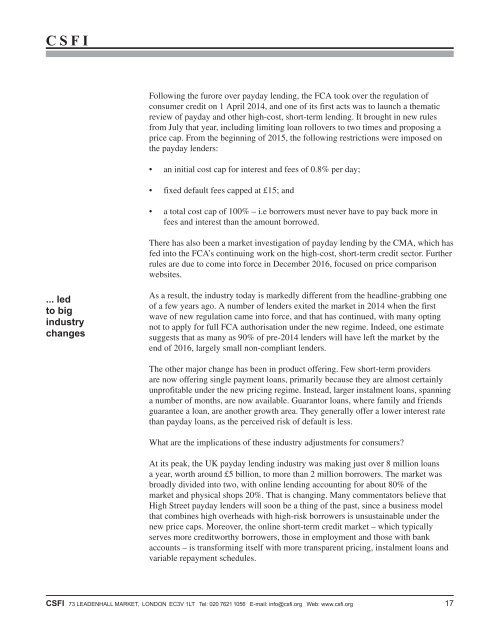CSFI
CSFI+-+Reaching+the+poor+-+release+version
CSFI+-+Reaching+the+poor+-+release+version
Create successful ePaper yourself
Turn your PDF publications into a flip-book with our unique Google optimized e-Paper software.
<strong>CSFI</strong><br />
Following the furore over payday lending, the FCA took over the regulation of<br />
consumer credit on 1 April 2014, and one of its first acts was to launch a thematic<br />
review of payday and other high-cost, short-term lending. It brought in new rules<br />
from July that year, including limiting loan rollovers to two times and proposing a<br />
price cap. From the beginning of 2015, the following restrictions were imposed on<br />
the payday lenders:<br />
• an initial cost cap for interest and fees of 0.8% per day;<br />
• fixed default fees capped at £15; and<br />
• a total cost cap of 100% – i.e borrowers must never have to pay back more in<br />
fees and interest than the amount borrowed.<br />
There has also been a market investigation of payday lending by the CMA, which has<br />
fed into the FCA’s continuing work on the high-cost, short-term credit sector. Further<br />
rules are due to come into force in December 2016, focused on price comparison<br />
websites.<br />
... led<br />
to big<br />
industry<br />
changes<br />
As a result, the industry today is markedly different from the headline-grabbing one<br />
of a few years ago. A number of lenders exited the market in 2014 when the first<br />
wave of new regulation came into force, and that has continued, with many opting<br />
not to apply for full FCA authorisation under the new regime. Indeed, one estimate<br />
suggests that as many as 90% of pre-2014 lenders will have left the market by the<br />
end of 2016, largely small non-compliant lenders.<br />
The other major change has been in product offering. Few short-term providers<br />
are now offering single payment loans, primarily because they are almost certainly<br />
unprofitable under the new pricing regime. Instead, larger instalment loans, spanning<br />
a number of months, are now available. Guarantor loans, where family and friends<br />
guarantee a loan, are another growth area. They generally offer a lower interest rate<br />
than payday loans, as the perceived risk of default is less.<br />
What are the implications of these industry adjustments for consumers?<br />
At its peak, the UK payday lending industry was making just over 8 million loans<br />
a year, worth around £5 billion, to more than 2 million borrowers. The market was<br />
broadly divided into two, with online lending accounting for about 80% of the<br />
market and physical shops 20%. That is changing. Many commentators believe that<br />
High Street payday lenders will soon be a thing of the past, since a business model<br />
that combines high overheads with high-risk borrowers is unsustainable under the<br />
new price caps. Moreover, the online short-term credit market – which typically<br />
serves more creditworthy borrowers, those in employment and those with bank<br />
accounts – is transforming itself with more transparent pricing, instalment loans and<br />
variable repayment schedules.<br />
<strong>CSFI</strong> 73 LEADENHALL MARKET, LONDON EC3V 1LT Tel: 020 7621 1056 E-mail: info@csfi.org Web: www.csfi.org 17


